Exploring the Importance of Mohammed Bin Zayed Street
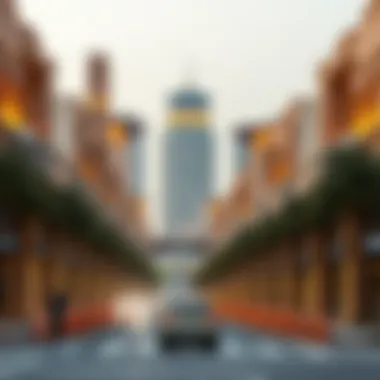
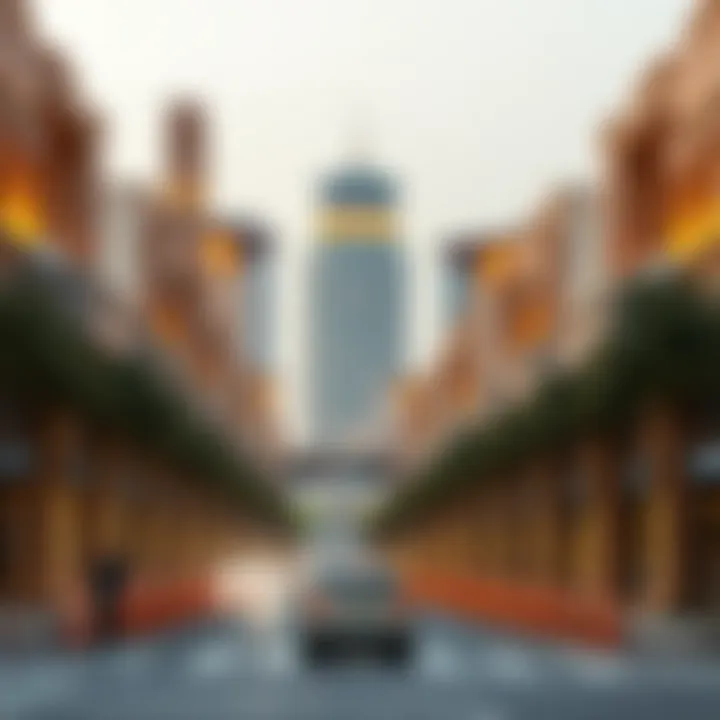
Intro
Mohammed Bin Zayed Street, previously known as Sheikh Zayed Road, stands as a vital artery in Dubai's urban framework. This thoroughfare encapsulates the rapid transformation of the city, bridging the past with the present while holding promise for the future. With skyscrapers piercing the skyline and diverse commercial enterprises lining its route, this street is not merely a pathway for vehicles; it is a vibrant reflection of Dubai's spirit and ambition. As an expat, investor, or analyst looking at Dubai's real estate landscape, understanding the nuances of this thoroughfare is indispensable.
The significance of Mohammed Bin Zayed Street stretches from its foundational history to its modern-day dynamics. This street has evolved into an emblem of progress and opportunity, shaping not only the city’s geography but also its culture and economy. As such, this article aims to dissect the multifaceted aspects of the street, highlighting market trends, investment opportunities, and the overarching influence it wields in shaping Dubai's urban identity and lifestyle.
Historical Context
Understanding the historical context of Mohammed Bin Zayed Street is crucial for appreciating its role within Dubai's urban framework. The evolution of this thoroughfare reflects the broader narrative of Dubai's transformation from a modest trading post into a bustling metropolitan paradise. It reveals the city's ambitions, its challenges, and how each phase of development has shaped the street itself.
Origins of Mohammed Bin Zayed Street
The origins of Mohammed Bin Zayed Street can be traced back to the early days of Dubai's development. Initially, what we now recognize as a major artery was simply a modest route used primarily for local trade and travel. As Dubai began to flourish in the 20th century, the need for more efficient infrastructure became evident. The street's development was spurred by a growing economy, where traders and expatriates played pivotal roles. It gradually evolved from a simple road into a significant highway, named after Sheikh Mohammed bin Zayed Al Nahyan to honor his contributions to the region, particularly in fostering unity and growth between the emirates.
People often think of roadways as mere connectors; however, they often symbolize the lifeblood of a city. For Dubai, this street signifies the crossroads of tradition and modernity. It's not just about vehicles moving back and forth; it highlights how far the city has come while remaining connected to its roots.
Evolution Over the Years
The evolution over the years of Mohammed Bin Zayed Street is a testament to the rapid urban development occurring in Dubai. As the city catapulted into global prominence, this thoroughfare underwent several phases of expansion and enhancement. One notable phase occurred during the early 2000s, when the city started investing heavily in infrastructure. This included expanding the street into a multi-lane highway, integrated with state-of-the-art traffic management systems to accommodate the increasing number of vehicles and commercial activities.
Additionally, the evolution of the surrounding areas showcases how the street influences real estate dynamics and local businesses. From humble shops catering to nearby neighborhoods to upscale malls and corporate offices, the areas along Mohammed Bin Zayed Street have witnessed a thriving commercial landscape.
"The street is more than just asphalt; it is a barometer of Dubai's growth, reflecting the ambitions and lifestyle transformations of its people."
While the evolution has its advantages, it also comes with challenges. The need for balancing development with sustainability issues has become increasingly pressing. As the street continues to evolve, residents and planners must consider how to maintain its utility while ensuring that it serves as a community space, not merely a thoroughfare. Understanding this evolution is essential for investors and expatriates looking to engage with Dubai's ever-changing urban environment.
Urban Planning and Design
Urban planning and design play an essential role in shaping the functionality, accessibility, and aesthetic appeal of Mohammed Bin Zayed Street. This thoroughfare is not just a means of transportation; it serves as a critical backbone of urban life. Proper urban planning transforms ordinary streets into vibrant spaces that cater to the needs of residents, businesses, and visitors alike.
Architectural Trends Along the Street
As the city expands, so does Mohammed Bin Zayed Street, adapting to contemporary architectural trends that reflect Dubai's dynamic essence. The buildings lining the street are a testament to innovation and visionary design. From sleek glass facades that shimmer under the desert sun to classical elements echoing a sense of history, the architecture here tells diverse stories. Architectural firms take advantage of sustainable building practices, ensuring that new structures are energy-efficient and environmentally friendly.
Many buildings are multifunctional, combining residential, retail, and office spaces. For instance, the mixed-use towers not only provide homes but also accommodate cafes, shops, and entertainment venues. This design encourages a live-work-play environment, minimizing the need for long commutes and promoting community interaction. Architects are often seen blending nature into these designs, with rooftop gardens and landscaped terraces becoming commonplace; this not only enhances the visual appeal but improves air quality and urban biodiversity.
Integration with Surrounding Areas
The integration of Mohammed Bin Zayed Street with its surrounding neighborhoods is deliberate and strategic. This street facilitates seamless connectivity between various districts, creating a network that supports both public and private transport modes. Local urban planners understand that effective connectivity enhances accessibility, which in turn drives foot traffic and boosts local economies.
Surrounding areas like Dubai Marina and Jumeirah are within easy reach, making the street a preferred route for commuters and tourists. Recently, initiatives have been introduced to improve pedestrian pathways and bicycle lanes. Not only does this promote healthier lifestyle choices, but it also aligns with Dubai’s commitment to sustainability.
Furthermore, planners focus on enhancing public spaces along the street. Parks, community gardens, and recreational areas provide residents with spots to unwind and connect with nature. The design philosophy behind such integration lies in the belief that urban landscapes should foster community engagement and inclusivity.
"Urban planning is not just about zoning spaces; it's about weaving life into the fabric of the city." - Unknown
Economic Impacts
Understanding the economic impacts of Mohammed Bin Zayed Street is crucial for appreciating its role in shaping Dubai's urban environment. This street not only facilitates traffic but also serves as a backbone for investment and local business growth. As Dubai continues to develop at a breakneck pace, embracing new technology and varied investments, this thoroughfare stands at the heart of these opportunities, influencing both local and global economic scenarios.
Investment Opportunities
The potential for investment along Mohammed Bin Zayed Street is nothing short of remarkable. Over the years, the street has attracted both local and foreign investors looking to capitalize on its strategic location and accessibility. Real estate ventures along this stretch have burgeoned, thanks in part to the increasing demand for both commercial and residential spaces.
- Commercial Investments: High-profile projects featuring mixed-use developments are on the rise. For instance, recent initiatives have included upscale shopping districts and modern office complexes, heightening its allure for businesses aiming to establish a presence in Dubai.
- Residential Prospects: The housing market in this area is equally lucrative. As expats flock to Dubai for work, the need for unique and diverse housing solutions grows. Many investors are developing high-rise apartments that offer everything from luxurious amenities to community-centric designs.
- Government Initiatives: Policies put forth by the Dubai government to encourage investment further enhance opportunities. With various incentives like tax breaks, streamlined business setup processes, and transparent regulations, investors find themselves in an increasingly favorable environment.
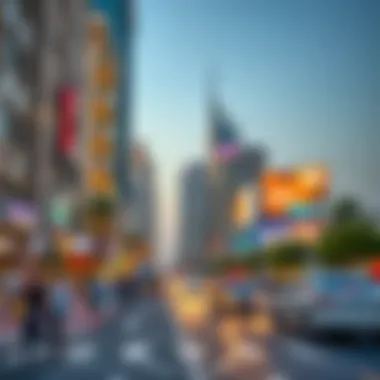
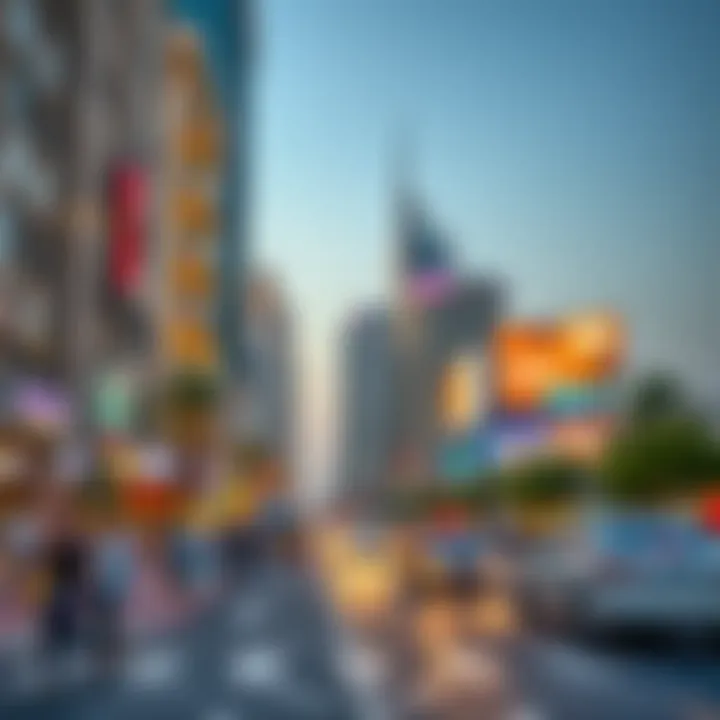
Overall, the street acts as a dynamic hub for investment, encouraging a variety of sectors to establish themselves and thrive, from retail to hospitality.
Growth of Local Businesses
The vibrancy of Mohammed Bin Zayed Street is largely powered by the small and medium enterprises that have opened doors there. This growth is a testament to the local economy’s resilience and adaptability.
- Diverse Industries: Entrepreneurs have seized the opportunity to establish cafes, boutiques, and service-based businesses that cater to both a local audience and the influx of tourists. This variety not only enriches the street's atmosphere but also promotes inter-business collaboration.
- Networking: Local businesses benefit from the proximity to one another, leading to synergies that foster innovation and support. Pop-up markets and local festivals provide platforms for these businesses to engage directly with consumers, enhancing community spirit while driving sales.
- Support from Local Government: Programs aimed at supporting startups and local businesses contribute significantly to this economic segment. Initiatives such as training programs and grants aimed specifically at entrepreneurs on Mohammed Bin Zayed Street instill confidence in new business ventures.
"The growth of local businesses not only strengthens the economy but also adds character to the urban landscape, creating a unique identity for Mohammed Bin Zayed Street."
Real Estate Dynamics
The real estate dynamics of Mohammed Bin Zayed Street hold a significant role in illustrating the development patterns and investment potential within Dubai. This thoroughfare serves as more than just a pathway through the city; it reflects economic vitality while shaping the property landscape. Investors and potential buyers can glean vital insights into the trends and movements of real estate, making it a focal point for discussions on growth and sustainability in urban planning.
Residential Developments
The residential landscape along Mohammed Bin Zayed Street has witnessed a spectacular transformation over the past decades. New housing projects cater to various lifestyles, attracting a diverse community of nationals and expatriates alike. Towering apartment complexes, upscale villas, and affordable housing options are sprouting up, ensuring accessibility for a range of income brackets.
Among the notable residential projects, developments like the Al Waleed Residential Complex and the prestigious Mohammed Bin Rashid City stand out. These neighborhoods offer not just homes but also community facilities such as parks, schools, and shopping areas, enhancing the living experience. The unique positioning of these properties, close to educational institutions and health clinics, tends to appeal to families looking for convenience.
The allure of these residential developments is further amplified by their proximity to essential services. Homeowners enjoy being just a stone's throw away from major commercial hubs, making the commute a breeze. This factor, in turn, raises property values, making investments in residential properties along the street a tantalizing opportunity.
Commercial Properties
Commercial real estate along Mohammed Bin Zayed Street is seeing a flourishing trend, driven by the increasing demand for retail spaces, office buildings, and mixed-use developments. The street is a nexus for businesses ranging from local shops to multinational companies, benefiting from high visibility and accessibility.
Several prominent establishments have staked their claim in the area, including the Dubai Mall and the upcoming Dubai Expo 2025 venue, which promises a influx of visitors and locals alike. These enterprises not only contribute to the local economy but also attract further investment into the surrounding properties, enhancing their appeal in the real estate market.
Moreover, the integration of commercial properties with residential developments creates a symbiotic relationship, where businesses benefit from foot traffic while residents enjoy easy access to amenities. This dual-functioning of spaces cultivates a vibrant urban environment, facilitating social interaction and community engagement.
Future Projects and Trends
Looking ahead, Mohammed Bin Zayed Street is poised for continued evolution. Various projects on the horizon promise to reshape the real estate landscape, with an emphasis on sustainability and smart technology. Developers are increasingly focusing on eco-friendly designs and energy-efficient buildings, which not only cater to the growing environmental concerns but also appeal to socially-conscious buyers.
Plans for smart city initiatives involving automated services for residents and commercial enterprises showcase a future where technology transforms how urban spaces function. Additionally, ongoing investments in public transport connectivity indicate a smoother flow for residents and visitors, further cementing the street’s reputation as a prime location for both residential and commercial ventures.
"The real estate scene along Mohammed Bin Zayed Street is a vibrant testament to Dubai's rapid development and future vision, making it a fertile ground for investors."
In summary, the real estate dynamics of Mohammed Bin Zayed Street reflect a blend of residential and commercial growth that is poised to thrive. With the evolving landscape, prospective investors, agents, and buyers have ample opportunities to explore, making it an integral part of Dubai's urban fabric.
Cultural Significance
The cultural significance of Mohammed Bin Zayed Street cannot be overstated. This thoroughfare is more than just a roadway; it serves as a dynamic artery that breathes life into Dubai's rich mosaic of traditions, arts, and modern influences. With its unique blend of cultural venues and active community engagement, the street reflects the essence of Dubai's identity, where the past and present converge. For investors and expatriates alike, understanding this vibrancy offers insights into the lifestyle that characterizes the area and presents various opportunities for participation in its cultural fabric.
Cultural Venues and Landmarks
Mohammed Bin Zayed Street is flanked by a variety of cultural venues that offer glimpses into both traditional and contemporary art. Notable landmarks include the Dubai Fine Arts Gallery, which regularly showcases exhibitions from local and international artists. People visiting the gallery experience pieces that tell stories of Dubai’s heritage and modern aspirations.
Moreover, the street is home to several museums, such as the Museum of the Future, which presents innovative exhibits that reflect the region’s ambitions for the future. These venues not only facilitate cultural exchange but also attract tourists seeking unique experiences.
A leisurely stroll down this street reveals:
- Art Installations: Interactive pieces positioned throughout public spaces allow passersby to engage with art in everyday settings.
- Cultural Festivals: Events such as Art Dubai and the Dubai International Film Festival occur in proximity to this area, contributing to the rich cultural narrative.
- Theatre and Performance Spaces: Places like the Dubai Opera contribute to making this street a lively hub for arts and performances, from operatic performances to contemporary dance shows.
With each venue fostering a sense of community and artistic expression, the street firmly supports Dubai's goal to be a global cultural hub.
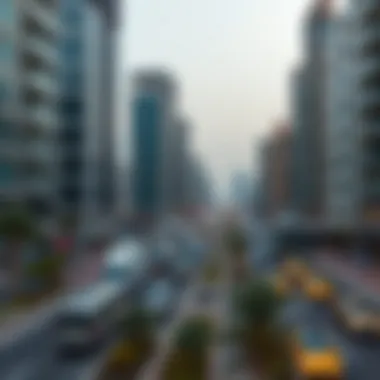
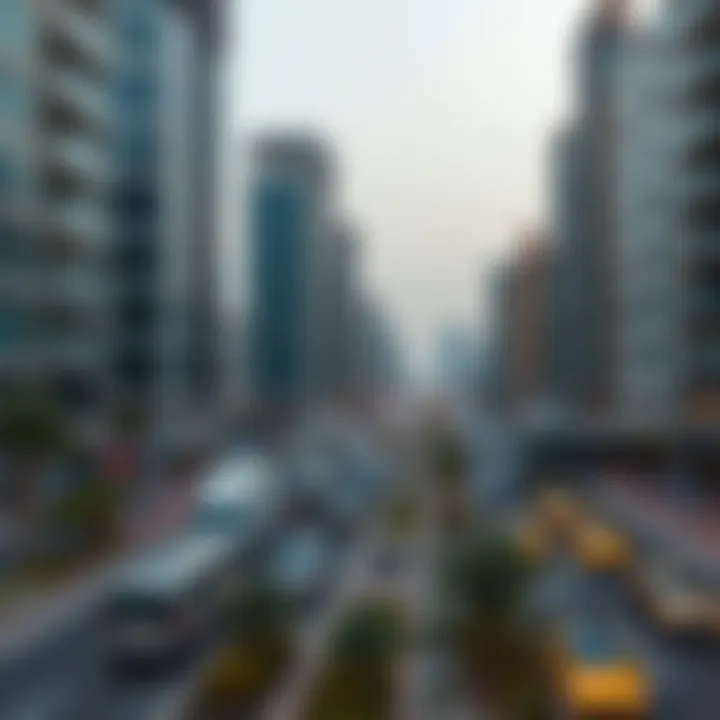
Community Engagement Initiatives
Community engagement along Mohammed Bin Zayed Street further enhances its cultural significance. Various initiatives aim to involve residents, local businesses, and visitors in fostering a sense of ownership and pride in their surroundings. One notable program is the community-driven mural projects that allow local artists to showcase their talents on building facades. This not only beautifies the urban landscape but encourages public interaction with art.
Additionally, workshops, classes, and cultural events take place regularly, focusing on topics ranging from traditional Emirati crafts to modern digital art, inviting participation from all demographics. The inclusion of initiatives like:
- Neighborhood Events: Regularly scheduled activities, such as food festivals and cultural showcases, connect residents and promote local cuisine and customs.
- Public Discussions and Forums: These aim to bridge gaps between the community and policymakers, ensuring everyone's voice is heard in the development of public spaces.
- Volunteer Programs: Opportunities for residents to get involved in local arts initiatives allow them to actively contribute to the cultural landscape.
Engaging the community is not just about participation; it’s about fostering connections that uplift the spirit of collaboration and creativity.
In sum, the cultural significance of Mohammed Bin Zayed Street lies in its ability to foster connections through art, community events, and engaging initiatives. For investors and expatriates looking to understand lifestyle dynamics, recognizing these cultural elements is key to appreciating the broader social fabric of Dubai.
Transport and Connectivity
Transport and connectivity are vital components of Mohammed Bin Zayed Street's significance within Dubai's urban landscape. An efficient transport system forms the backbone of any bustling metropolis, facilitating the movement of people and goods. In Dubai, Mohammed Bin Zayed Street serves not just as a key roadway but as a crucial artery within the larger fabric of the city's infrastructure.
The street connects various districts across Dubai, making it essential for commuters, visitors, and businesses alike. It plays a pivotal role in bridging gaps between residential areas, commercial hubs, and cultural landmarks, thus enhancing the overall accessibility for everyone.
Public Transport Systems
Dubai boasts a sophisticated public transport network that significantly enhances the appeal of Mohammed Bin Zayed Street. The integration of various systems such as buses, metro lines, and taxis ensures that reaching different parts of the city is a breeze. The road itself is lined with numerous bus stops, which cater to thousands of passengers daily.
To illustrate:
- Dubai Metro: The nearest metro station to Mohammed Bin Zayed Street provides easy access to this vital area. With trains running frequently, commuters can skip the traffic and arrive at their destination with ease.
- Public Buses: Serving as the backbone of public transport, Dubai's RTA buses facilitate travel directly along and off the street, making it accessible for residents and tourists.
Additionally, the implementation of smart transportation solutions further enhances the efficiency of public transit, thus promoting an eco-friendly commuting option. Information displays at bus stops, along with the RTA's smartphone applications, allow users to check arrivals in real time, optimizing their travel plans.
Accessibility Features
Accessibility is not just about getting from point A to point B; it’s about how comfortably and safely individuals can navigate the urban environment. Mohammed Bin Zayed Street incorporates a variety of features designed to ensure inclusivity for every individual, including those with disabilities.
- Pedestrian Walkways: Wide sidewalks lined with tactile paving help guide visually impaired individuals, while also providing plenty of space for pedestrians.
- Ramps and Crossings: Strategically placed ramps at intersections allow wheelchair users and those with mobility challenges to cross the road with relative ease.
Moreover, several unitate and informative signages placed along the street provide clear direction and vital information, enhancing the user experience for both locals and visitors. This thoughtful consideration of urban design not only adheres to international accessibility standards but also promotes an inclusive community spirit.
"Transport is a lifeline in cities; in Dubai, it’s a vibrant thread weaving together diverse cultures and lifestyles."
Overall, the transport systems and accessibility features associated with Mohammed Bin Zayed Street exemplify Dubai's commitment to fostering an interconnected urban environment. This enhances the street's prominence as a pivotal area for business and leisure, catering to a diverse population while also appealing to prospective investors and expatriates looking to make their mark in this thriving city.
Lifestyle Influences
The lifestyle along Mohammed Bin Zayed Street is a reflection of Dubai’s rapid development and cosmopolitan culture. This street is not just a mere passageway; it embodies the essence of everyday life for its residents and visitors alike. The proximity of residential communities to key amenities creates a vibrant atmosphere where modern living meets traditional values. This duality is vital in understanding how this thoroughfare shapes daily experiences and community interactions.
Residential Community Life
Residential areas adjacent to Mohammed Bin Zayed Street have evolved into thriving neighborhoods characterized by their diverse demographic. Many expatriates from different corners of the world have chosen to call this area home, creating a mosaic of cultures and traditions.
These communities often feature well-designed housing that caters to various budgets. From sprawling villas to sleek apartment complexes, the options available contribute to the street's appeal. The presence of parks, schools, and healthcare facilities enhances the quality of life for residents. Consider this:
- Green Spaces: Parks along the street offer a breath of fresh air amidst the urban hustle, providing a space for family gatherings and recreation.
- Community Centers: These hubs facilitate social engagements, fostering a sense of belonging.
- Safety and Security: The neighborhoods are often secured with surveillance and patrols, allowing families to feel at ease in their surroundings.
Life here is enriched by these elements, making it more than just a convenient location; it promotes social cohesion among its residents.
Retail and Leisure Destinations
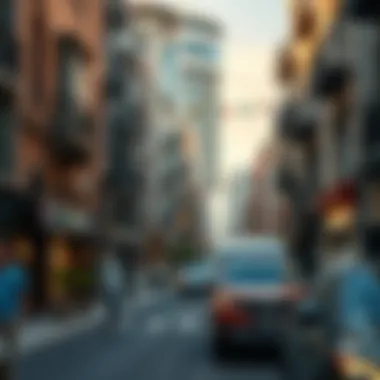

The stretch of Mohammed Bin Zayed Street is aligned with some of the best retail and leisure experiences in Dubai. Shopping malls, boutique shops, and entertainment venues are easily accessible, catering to a wide array of tastes and preferences. This accessibility fuels the local economy and instills a vibrant atmosphere.
Signature shopping spots include renowned malls where families can spend weekends snagging goods or enjoying movies together. Restaurant strips tempt the palate with cuisines from around the world, drawing food enthusiasts from all walks of life. Points to note include:
- Diverse Shopping Options: From high-end brands to local crafts, the shopping scene here is ever-evolving, keeping residents engaged.
- Cafés and Restaurants: Culinary delights dot the landscape, serving as social meeting points for friends and families.
- Entertainment Spaces: Movie theaters and event venues host a variety of entertainment, providing a lively backdrop to weekends.
The leisure facilities contribute to a balanced lifestyle. For investors and potential buyers, these qualities present not only a compelling living environment but also highlight the lucrative prospects tied to lifestyle-oriented real estate.
"The lifestyle cultivated around Mohammed Bin Zayed Street is pivotal for those considering investing in Dubai’s urban fabric. It reflects a blend of opportunity, culture, and community."
Challenges and Opportunities
Mohammed Bin Zayed Street stands as a symbol of Dubai's expansive growth and urban ambitions. However, with progress comes its own set of hurdles and chances. An in-depth analysis of these factors helps showcase how the street's evolution can offer invaluable insights for investors, agents, expatriates, analysts, and buyers alike.
Urbanization Challenges
As Dubai continues its meteoric rise as a global hub, urbanization challenges loom large. One significant issue is traffic congestion. The influx of new residents and businesses has created a heavy demand for transportation infrastructure. During peak hours, navigating Mohammed Bin Zayed Street can feel like trying to swim upstream in a river. This bottleneck not only slows down daily commutes but poses a barrier for businesses that rely on the timely movement of goods.
Additionally, rapid urban sprawl increases the pressure on public services. Schools, healthcare facilities, and recreational areas struggle to keep pace with the growing needs of a diverse population. Residents may find themselves on long waiting lists for enrolling their children in schools, while healthcare providers work hard to accommodate an increasing number of patients. As these services come under strain, it can lead to discontent among citizens and expatriates alike.
Another critical aspect of urban challenges relates to environmental concerns. As concrete structures multiply, the balance of natural ecosystems can tip. Public authorities now find it crucial to tackle issues such as air pollution and increased heat, which can seriously affect the quality of life. Such challenges, if left unaddressed, may hamper further investments and development along this significant corridor.
"Understanding urbanization challenges is not just for academics; it’s vital for stakeholders in the Dubai landscape to anticipate the implications of growth and act wisely on them."
Sustainable Development Initiatives
In response to the challenges, sustainable development initiatives have emerged as key strategies for enhancing the potential of Mohammed Bin Zayed Street. The Dubai 2040 Urban Master Plan provides a comprehensive roadmap aimed at promoting sustainability while accommodating growth. Thus, this initiative emphasizes creating walkable neighborhoods, mixed-use spaces, and green corridors to foster a healthier urban environment.
Implementing innovative green technologies is another removable stride forward. For instance, the incorporation of energy-efficient buildings and smart public lighting systems helps reduce the carbon footprint in a dynamic area noted for its lavish construction. By using solar panels and rainwater harvesting systems, developers can create smart buildings that not only meet today’s demands but are also prepared for tomorrow’s challenges.
Moreover, community engagement plays a pivotal role in the approach to sustainable initiatives. Public consultations can empower residents to voice their concerns and desires regarding development projects. When the street's community collaborates with local authorities, the results are projects that resonate more with the citizens’ needs.
The linking of transportation plans with sustainability efforts cannot be overlooked. Expansion of public transport options, including bus and metro services, helps reduce reliance on personal vehicles, easing congestion, and lowering emissions. Enhanced connectivity helps facilitate mobility, encouraging more residents and visitors to explore Mohammed Bin Zayed Street and all it has to offer.
Understanding both the challenges and opportunities along Mohammed Bin Zayed Street can not only guide effective urban planning but also offer fertile ground for investment. As Dubai adapts to the evolving urban landscape, stakeholders have a unique opportunity to shape the future of one of its most cherished thoroughfares, making it a thriving part of the city’s tapestry.
Future Prospects for Mohammed Bin Zayed Street
The future of Mohammed Bin Zayed Street stands as a reflection of Dubai's ambitious valor in modern urban development, entwining both opportunity and challenge. It’s paramount for investors to span their gazes not just toward immediate gains but also potential that lies on the horizon. With rapid globalization and burgeoning populations, this thoroughfare isn't merely a path for vehicles and pedestrians; it’s shaping up to be a lifeline for commerce, culture, and community engagement in a city that never ceases to reinvent itself.
Long-Term Urban Development Plans
Over the years, Mohammed Bin Zayed Street has been subjected to a phalanx of infrastructural advancements. There’s a keen emphasis on sustainable design practices, which is becoming an integral part of the fabric of urban planning. City planners are looking into ways to optimize land use, improve traffic flow, and enhance the quality of life for residents.
- Road Expansion Initiatives: Plans are afoot to widen certain sections, transforming bottlenecks into smooth transitions, ultimately facilitating better access to key areas throughout Dubai.
- Smart City Integration: With the advent of smart technology, a push is on to integrate intelligent traffic systems along the street. This aims to minimize traffic congestion and enhance safety measures as cities evolve digitally.
- Green Spaces: Urban green spaces are becoming a focal point in future developments. Initiatives like parks and pedestrian zones will foster community interaction and provide a breather from the city's hustle and bustle.
As these long-term plans materialize, they hold the promise of making Mohammed Bin Zayed Street a pillar of progressive urban living, synergizing transit and tranquility.
Potential Impact on Dubai’s Real Estate Market
When it comes to real estate, Mohammed Bin Zayed Street plays a pivotal role in shaping the market dynamics of Dubai. Its continuous evolution marks an increasing demand for residential and commercial properties. Consider the following impacts:
- Increased Property Values: As infrastructural developments progress, property values in the vicinity are expected to soar. Investors and homebuyers are keen to be part of this growth, which is likely to yield significant returns in the coming years.
- Diversification of Offerings: From luxury apartments to more affordable housing, the market is expanding to cater to a larger demographic. This diversity attracts a varied mix of residents, helping to foster an enriched community.
- Commercial Growth: With businesses looking to capitalize on the influx of foot traffic, expect a surge in retail spaces, cafes, and service-oriented developments along the street. The area's vitality will contribute positively to the overall economic landscape of Dubai.
In summary, stakeholders from various sectors will need to keenly observe the unfolding developments along Mohammed Bin Zayed Street, as they can tap into the burgeoning opportunities that arise from its ongoing transformation.
"The evolution of Mohammed Bin Zayed Street signifies not a mere change in infrastructure, but a reshaping of urban identity and investment potential in Dubai."
For more detailed information on urban structures and real estate developments, consider visiting:
By aligning with these trends, planners and investors can contribute to the sustainable growth trajectory of one of the world's most dynamic cities.



